Oat Kernel Damage
Principal OAT Kernel Damage
Badly Ground and/or weather damage
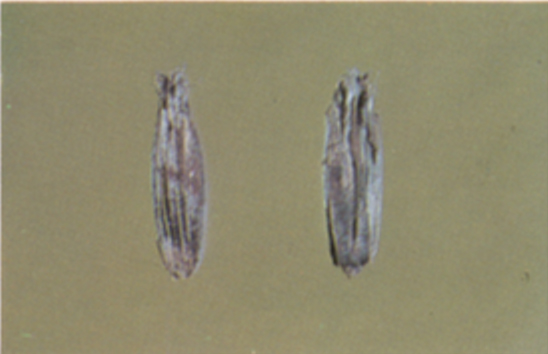
Kernels which are badly discolored by ground and/or weather conditions shall be considered damaged and scored against sound oats.
Germ Damage (sick and/or mold)
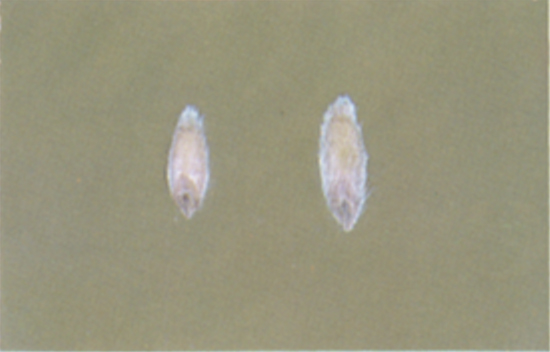
Kernels in which the germ is discolored or moldy as a result of respiration shall be considered damaged and scored against sound oats.
Heat Damage
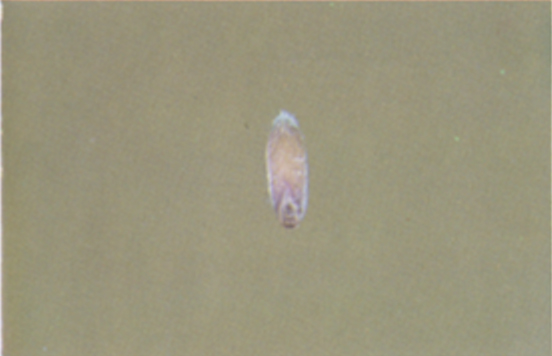 Kernels which are materially damaged as a result of heating and which show a reddish
discoloration extending back from the germ shall be considered damaged and scored
against sound oats. Note: The hulls must be removed to determine the extent of heat
damage.
Kernels which are materially damaged as a result of heating and which show a reddish
discoloration extending back from the germ shall be considered damaged and scored
against sound oats. Note: The hulls must be removed to determine the extent of heat
damage.
Insect Damage
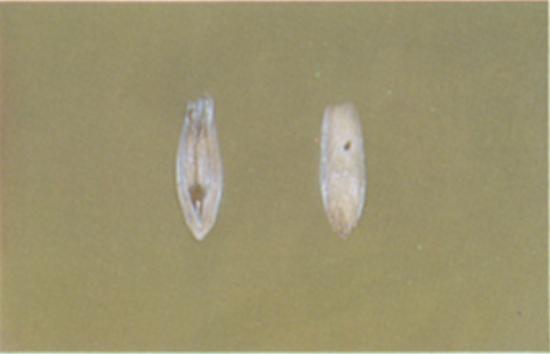
Kernels which have been bored or tunneled by insects shall be considered damaged and scored against sound oats.
Sprout Damage

Kernels which have sprouted or which generally have a crack in the seedcoat over the germ area shall be considered damaged and scored against sound oats. The hull must be removed to determine if the cracked seedcoat indicated sprouting.
Wild oats
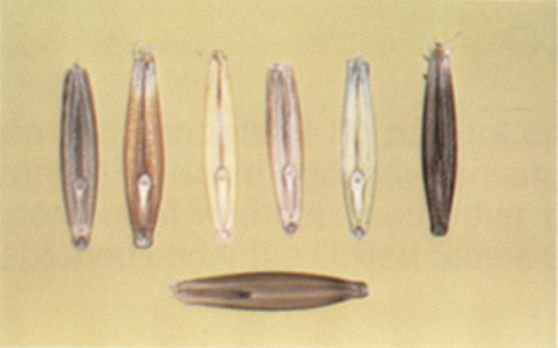
Seeds of Avena Fatua and A. Sterilus. Wild oats are usually identified by their characteristic slender kernels with twisted awns (so-called “sucker mouths”) and basal hairs or bristles on the germ end of the kernels.
Appearance Factors
Slightly weathered. In order for a sample of oats to be designated slightly weathered,
- each individual kernel may have a slightly dusty, grey appearance on the brush end in sufficient amounts so that the entire sample has a slightly weathered appearance or
- the sample may contain a sufficient number of severely weathered kernels giving it a slightly weathered appearance.
In either case, the oats shall be considered slightly weathered and shall not grade higher than U.S. No. 3.
Badly stained or materially weathered. When discoloration due to weather has progressed to a point where many of the kernels are badly discolored and weathered, the oats shall be considered badly stained or materially weathered and grade no higher than U.S. No. 4.
Other Grading Factors
Foreign material. All matter other than oats, wild oats, and other grains. Oat clippings
and detached oat hulls and pieces of detached hulls are foreign material.
Other grains. Barley, corn, cultivated buckwheat, einkorn, emmer, flaxseed, guar,
hull-less barley, non-grain sorghum, polish wheat, popcorn, poulard wheat, rice, rye,
safflower, sorghum, soybeans, spelt, sunflower seed, sweet corn, triticale, and wheat.
Bleached oats. Oats that in whole or part, have been treated with sulfurous acid
or any other bleaching agents.
Bright oats. Oats, except bleached oats, that are of good natural color.
Ergoty oats. Oats that contain more than 0.10 percent ergot.
Extra-heavy oats. Oats that have a test weight per bushel of 40 pounds or more.
Garlicky oats. Oats that contain 4 or more green garlic bulblets or an equivalent
quantity of dry or partly dry bulblets in 500 grams of oats.
Heavy oats. Oats that have a test weight per bushel of 38 pounds or more but less
than 40 pounds.
Smutty oats. Oats that have kernels covered with smut spores to give a smutty appearance
in mass, or that contain more than 0.2 percent of smut balls.
Thin oats. Oats that contain more than 20.0 percent of oats and other matter, except fine seeds, that pass through a 0.064 x 3/8 oblong-hole sieve. Fine seeds are all matter that passes through a 5/64 triangular-hole sieve.
Special Grades
Infested
Oats that are infested with live weevils or other live insects injurious to stored
grain.  Oats are considered infested when the representative sample, or lot as a whole (stationary)
or component sample (continuous loading/unloading of shiplots and bargelots) contains
two or more live weevils, or one live weevil and five or more other live insects injurious
to stored grain, or ten or more other live insects injurious to stored grain.
Oats are considered infested when the representative sample, or lot as a whole (stationary)
or component sample (continuous loading/unloading of shiplots and bargelots) contains
two or more live weevils, or one live weevil and five or more other live insects injurious
to stored grain, or ten or more other live insects injurious to stored grain.
Grade Requirements for oats
| Grade | Minimum limits test weight per bushel (lbs) | Minimum limits sound oats (%) | Maximum limits heat damaged kernels (%) | Maximum limits foreign material (%) | Maximum limits wild oats (%) |
|---|---|---|---|---|---|
| U.S. No. 1 | 36.0 | 97.0 | 0.1 | 2.0 | 2.0 |
| U.S. No. 2 | 33.0 | 94.0 | 0.3 | 3.0 | 3.0 |
| U.S. No. 31 | 30.0 | 90.0 | 1.0 | 4.0 | 5.0 |
| U.S. No. 42 | 27.0 | 80.0 | 3.0 | 5.0 | 10.0 |
U.S. Sample grade-
U.S. Sample grade are oats that:
- Do not meet the requirements for the grades U.S. Numbers 1, 2, 3, or 4; or
- Contain 8 or more stones which have an aggregate weight in excess of 0.2 percent of the sample weight, 2 or more pieces of glass, 3 or more crotalaria seeds (Crotalaria spp.) 2 or more castor beans (Ricinus communis L.), 4 or more particles of an unknown foreign substance(s) or a commonly recognized harmful or toxic substance(s), 8 or more cockleburs (Xanthium spp.) or similar seeds singly or in combination, 10 or more rodent pellets, bird droppings, or equivalent quantity of other animal filth per 1 1/8 to 1 1/4 quarts of oats; or
- Have a musty, sour, or commercially objectionable foreign odor (except smut or garlic odor); or
- Are heating or otherwise of distinctly low quality.
1 Oats that are slightly weathered shall be graded not higher than U.S. No. 3
2 Oats that are badly stained or materially weathered shall be graded not higher than U.S. No. 4.
Oats
Grain that consists of 50 percent or more of oats (Avena Sativa L. and A. Byzantina C. Koch) and may contain, singly or in combination, not more than 25 percent of wild oats and other grains for which standards have been established under the Untied States Grain Standards Act.
Special Grade Designations
When applicable, a special grade is added to and made part of the grade designation. The grade designations for bright, extra-heavy, and heavy oats shall include preceding the word “oats,” the word(s) “bright,” “extra-heavy,” or “heavy,” as warranted. The grade designations for bleached, ergoty, garlicky, smutty, thin, and infested oats shall include, following the word oats, the word(s) “bleached,” “ergots,” “garlicky,” “smutty,” “thin,” or “infested,” as warranted.
Acknowledgments
We wish to express sincere appreciation to representatives of the Wichita Field Office
of the Federal Grain Inspection Service for their assistance in revising this publication.
Appreciation is also extended to the Oklahoma Grain & Feed Association, 2309 N. 10th,
Suite B, P.O. Box 1747, Enid, Oklahoma 73702.
The photographs appearing in this publication are printed by permission from S J Systems, 645 West Virginia, Milwaukee, Wisconsin 53204, (414) 271-7112. The photographs are reproductions of the line slides used by the Federal Grain Inspection Service and are intended for illustration only. Since the intensity of the reproductions may not precisely duplicate the originals, we do not recommend that they be used for grading purposes.
Authors:
Dr. Kim Anderson and Dr. Phil Kenkel
Department of Agricultural Economics
Cooperative Extension Service
Oklahoma State University
Roger Friedrich
Supervisory Physical Scientist
FGIS Technical Center
Kansas City, Missouri.
